Items
Tag
19th century
-
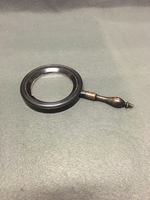
Magnifying Glass
The magnifying glass is made from black stained mahogany with a long decorative turned handle. -

Magnifying Glass
The Victorian "hammer" magnifying glass/loupe is made from brass and has a dark wood handle. The brass has two etched lines around the circumference of the lenses. The instrument would have been used by jewelers for inspecting their products or as a magnifying glass for reading. -

Compass Pocket Microscope with Magnifying Glass
The miniature botanist microscope has the original lens intact. The objective lenses are set in a Lieberkuhn reflector which reflects light evenly onto the specimen. The simple microscope seems to have an ivory or bone handle. There is an attachment with an inclination joint which allows the stage forceps to be angled for observation. The specimen holder is not original to the instrument. The instrument comes with a magnifying glass with a matching ivory (or bone) handle. -

Bausch & Lomb Universal Microscope
The universial microscope is made from brass and stands on a flat tripod foot. The limb is split into two by an inclination joint that allows the microscope to be angled for observation. The circular stage is missing its two stage clips which would hold the specimen in place. The monocular microscope has a substage aperture iris diaphragm which can be rotated to adjust the aperture. The arm of the mirror and condenser can be slotted into each other and are connected to a circular joint next to the stage which allows them both to be rotated. However, the microscope is missing its substage mirror and the two arms do not seem to slot into one another as they should. The coarse focusing functions via a rack and pinion mechanism which is controlled by the large thumbscrew on the side of the body tube. Fine focus is controlled by the small thumbscrew located on top of the limb. The microscope is signed "PAT. OCT. 3, 1876, PAT. OCT. 13, 1885" on the side of the pillar and "Bausch & Lomb Optical Co." on the stage. The mahogany case has a brass carry handle and is secured by a lock and key; however, the key is not present with the instrument. The case has an interior draw that holds the slides and accessories. The interior also has compartments for the objectives and ocular lenses, with the top compartment lined with blue velvet. -

Nachet et Fils Microscope
The compound microscope is made from brass and japanned cast iron. The instrument is signed "NACHET ET FILS 17 Rue St Severin Paris" at the front of the arm attachment which holds the body tube. The microscope stands on a H-shaped foot which is painted black and connected to the pillar. The pillar is curved and has a inclination joint which allows the microscope to be angled for observation. The sub-stage concave mirror is connected to the square stage by a gimbal and pin. The stage has two clips that hold the specimen for observation. The objective has three lens attachments and coarse focusing functions via a sliding mechanism of the body-tube through the draw tube. Fine focusing is controlled by the small thumbscrew located at the top of the limb. -

Candlestick with Condenser
The brass candlestick has a bulls-eye condenser attachment. The candle stick can function with or witho ut the attachment. This accessory was used as an artificial light source to the microscope if and when natural light was unavailable. Candlesticks and lamps were commonly used by microscopists with the added modification of the bulls-eye condenser. Its origins can be found in Robert Hooke and illustrations shown in his book, Micrographia, which show the use of a glass globe filled with water to help intensify and concentrate the light from a candle. The use of optics to intensify the light of a candle or lamp was explored more closely in the nineteenth century with the creation of the bulls-eye condenser, which became a popular accessory to a microscope. -

"Cary-Gould Style" Compound Microscope
The Gould-Cary style microscope — when assembled — is case mounted and the pillar screws into the top of the case. The substage mirror is connected via a gimbal and pin which allows for maneuvering to catch the light as well as easy removal from the microscope. The square fixed stage has a small bullseye condenser and specimen clip attached via a pin. The body-tube and objective lenses are attached via a screwing mechanism and can then be attached to the arm. Coarse focusing is controlled by the thumbscrew located next to the stage and uses a rack and pinion mechanism. The mahogany case is fitted and has compartments for the dissembled parts of the microscope. The interior of the lid is lined with blue velvet and the compartments are made from wood. The case is secured by two brass swivel hooks at the front of the case. -

J.B. Dancer Binocular Microscope
Manufactured by the "Committee of the Society" — now known as the Manchester Microscopical Society (RMS) — the microscope was designed according to Dancer's 1873 catalog. The microscope is a portable Wenham binocular instrument which is built on a Ross-bar style limb with the Wenham prism mounted into the body-tube, which holds the RMS standard objectives. The design was offered with either rack and pinion coarse focus or chain drive and this microscope coarse focusing functions via chain drive which is not currently working. Inter-ocular separation is by a simple (lightweight) lever mechanism, and the plain stage has a slide bar to hold and maneuver the specimen. The stage has a central hole threaded to take sub-stage accessories. Below the stage is a plano-concave mirror. The microscope is signed on the foot “J.B. Dancer Manchester” and is numbered “50.” Original mahogany box has original key and comprises of two inner pull out drawers. Inside the door is a Paper Label stating: '' PRIZE MEDAL 1862. J. B. DANCER, OPTICIAN, MANCHESTER, Inventor of Microscopic Photographs, manufacturer of all kinds of Optical and Mathematical Instruments, Binocular Achromatic Microscopes, Rifle Telescopes, Field Glasses, Achromatic Telescopes, &c., &c. By appointment to Her Majesty's Commissioners '' with two Motifs. -

Cary-Gould style Microscope
The monocular microscope is designed along the Cary-Gould style and mounted on the top of the orginal mahogany case. The compound microscope can be dissembled to fit into the fitted case. The limb is connected to an inclination joint that allows for the microscope to be angled for observation. The square fixed stage has two stage clips connected by pins and are detachable. The body-tube and objective are screwed into each other which is then screwed into the circular arm. The circular arm has a small bullseye condenser connected via a gimbal limb which makes it easy to maneuver. Coarse focusing functions via the sliding mechanism of the stage. The case has compartments lined with velvet to hold the different components of the microscope. The majority of the case has a wooden interior and the case is secured by two brass swing hooks. -

R & J Beck Educational Microscope
The compound microscope has a japanned claw-foot base and limb. The limb and body tube are connected by a trunnion joint that allows the microscope to angle when observing a specimen. The body tube, square stage and mirror fixture are made from brass. The body tube is connected to the curved limb, with the coarse focus controlled by a rack and pinion mechanism via a thumbscrew located at the side of the body tube. The microscope also has fine focus which is controlled by a thumbscrew on the front of the body tube. Underneath the fixed stage is a rotating iris diaphragm with 3 apertures. The substage mirror is connected via a gimbal attachment and rotates. The original case has a draw for accessories and a compartment for an objective canister. The case is made from mahogany and is secured by a lock and key, however, the key is not present with the microscope. -

Society of Arts-Style Compound Microscope
The monocular microscope has a Ross Y-shaped foot which is secured to a mahogany platform. The compound microscope is made of brass. The one-sided sub-stage mirror is attached to the bottom of the limb by a gimbal joint that allows it to be maneuvered to catch the light. Coarse focusing is achieved by a rack and pinion mechanism which is controlled by a thumbscrew at the side of the limb. The small thumbscrew at the back of the body-tube by the nose piece controls the fine focusing. The square fixed stage does not seem to have any means of securing specimens. The substage iris diaphragm that can be adjusted by rotating the disk. This microscope design followed the 1854 Society of Arts pattern. The fitted, solid mahogany case has brass hinge and handle. The lock is missing and the door is slightly warped. There are shrinkage cracks to the rear panel. -

Cary-Gould Pocket Microscope
The compound microscope is signed by "Cary of London" on the pillar and is made from brass. The microscope can be dissembled to fit into its small, fitted case. The pillar of the microscope is screwed into the front interior of the case. The gimbaled one-sided substage mirror is attached via a pin to the bottom of the pillar. The arm can be secured to the top of the pillar by sliding it into an attachment. Similarly to the substage mirror, the circular stage is attached via a pin into an attachment on the pillar. The fixed stage also has a section for dissecting forceps; however, only the hinge is present with the instrument. The attachment controls the coarse focusing by rack and pinion via a thumbscrew on the side of the microscope. The objective lenses screw into the bottom of the body-tube which is then screwed into the arm of the microscope.The arm was manufactured by UNC Charlotte College of Engineering on March 15, 2010. The mahogany case contains compartments that hold the dissembled parts of the microscope. The interior of the case is lined with worn, purple velvet. Two swinging brass hooks secure the case. -
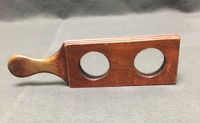
Binocular Magnifier
The handheld binocular magnifier is made from mahogany. The magnifier includes two ocular lenses set into a rectangle piece of wood. The magnifier also has a wooden handle. -

Monocular Compound Microscope
The compound microscope is made from lacquered brass and the Y-shaped foot is permanently attached to a mahogany platform. The monocular microscope has a mechanical stage which can be adjusted along a X and Y axis via two thumbscrews. One of the thumbscrews moves the stage horizontally; however, the vertical adjustment no longer works due to a hole in the adjustment gear. The coarse focusing is achieved via a rack and pinion mechanism which moves the body-tube closer or further away from the fixed square stage. Fine focusing functions via a thumbscrew located at the bottom of the body-tube. The stage has two holes on either side of the corners which can hold accessories such as stage forceps or bullseye condenser, however, no accessories come with the microscope. The sub-stage concave mirror is one-sided and is attached to the pillar. The style of the microscope is similar to the Robert Fields' 1855 Society of the Arts winning design. The fitted mahogany case is original to the microscope, which has a brass carry handle on the top of the case. The interior has 5 circular sections to hold the objectives and ocular lenses that come with the microscope. There is a small draw located in the top of the interior which holds slides. The keyhole escutcheon matches that of other Beck microscope images, so it may be by produced by R & J Beck. -

R & J Beck Compound Microscope
The R & J Beck's compound microscope is made from lacquered brass with a continental horseshoe base which is solid brass and has etched "R & J. Beck. Ltd London 26669" into the back of the base. On one of the sides of the base, "WILLIAMS BROWN & EARLE PHILADELPHIA" is etched into the foot. The substage double-sided mirror — which includes a concave side — is attached via a gimbal arm to a swinging tailpiece that is connected to the pillar. The square, mechanical stage is painted black and has two metal clips to secure a specimen. There are two holes on both corners of the stage in which accessories such as stage forceps can be attached. However, there are not any stage accessories with this microscope. There is also a substage iris diaphragm that can be adjusted via a lever on the outside. The coarse focusing functions via a rack and pinion mechanism which moves the body tube closer or further away from the fixed stage. The fine focusing mechanism is controlled by a thumbscrew located at the top of the pillar. The fitted case is original to the microscope and has compartments on the inside of the door that hold the objectives and ocular lenses. The case has a brass carry handle on top of the microscope and the case is secured with a lock; however, there is not a key with the microscope. -

J. Swift & Sons Histological Compound Microscope
The compound microscope is signed "J. Swift & Son. London. Patent 24960" on the base and the initial design was for Histology (the study of tissues.) The serial number "1275" is shown on Traviss-type mechanical stage. The base has four legs, with the back two on a swivel hinge so that it can collapse to fit inside the case. The draw-tube has a triple objective nose piece that revolves when needed. Coarse focusing functions via a rack and pinion mechanism that moves the body-tube closer or further from the mechanical stage. The thumbscrew on the top of the limb controls the fine focusing. The square stage measures 3.75" with engraved grid on surface. The stage has a sliding mechanism to position and secure the specimen. The sub-stage Abbe condenser has a iris diaphragm that functions via a rack & pinion vertical adjust. The dia plano-concave mirror is fixed onto a universal mount. The microscope comes with a fitted mahogany case with brass key and fittings. The interior of the case has compartments to hold the objectives and parts of the dismantled microscope. -

Charles Baker "Ross Type" Microscope
The Charles Baker compound microscope comes with the original mahogany case. The brass microscope can be dissembled to fit into the case. The body tube and arm are secured via a thumbscrew to the mahogany platform which is fixed to the claw-footed base of the microscope. The lacquered brass foot has "BAKER, 244 High Holborn, LONDON" carved into it. The body tube and arm can then be attached via a screw to the pillar of the microscope. The fixed square stage is attached to the pillar and has a square fixture that can be horizontal to adjust the specimen. There is a substage revolving diaphragms that can be removed via a sliding mechanism. Coarse focusing functions via a rack and pinion mechanism and fine focusing is operated via thumbscrew found on the arm. The substage, one-sided mirror is permanently attached to the pillar of the microscope via a gimbal. The mahogany case is farcened with a brass lock which is no longer present on the case with the escutcheon missing. The wooden fitting that would originally have held the two objectives in the case is half missing and so the accessories are now being held in the draw located at the bottom of the case. The draw has a brass pull loop to open and close it. The case also has a brass handle at the top that is used to carry the case. -

Drum Compound Microscope
The drum compound microscope is made of brass. The style was manufactured in France, Germany and England and sold throughout the United States and Europe. Many of the microscopes manufactured using this design were unsigned due to the huge quantities sold by various makers. The microscope consists of a body-tube suspended by a tubular base above a circular specimen platform. Coarse focus functions by moving the body-tube closer or further away from the specimen platform via a sliding mechanism operated by a thumbscrew. There is also a concave sub-stage mirror located at the bottom of the microscope. The "coffin-style" mahogany case has compartments for the microscope, slides and accessories. There was a small, decorative plaque on the top of the lid, however, it is no longer attached to the case. The case is secured via a lock and key; however, the key is not present with the microscope. -
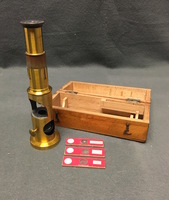
Drum Compound Microscope
The drum compound microscope is made from lacquered brass. The style was manufactured in France, Germany and England and sold throughout the United States and Europe. Many of the microscopes manufactured using this design were unsigned due to the huge quantities sold by various makers. The microscope consists of a body tube suspended by a tubular base above a circular specimen platform. The body tube is moved closer or further away from the specimen platform to coarse focus via a sliding mechanism. There is also a concave substage mirror located in the bottom of the microscope, which can be seen through a circular cut out. The "coffin-style" wooden case has compartment for the microscope and slides. The case is secured with two swing hooks. The microscope comes with the following accessories: 3 cardboard prepared slides. -

Microscope Light Screen
The Victorian microscope light/heat screen was used by microscopists to shield light while observing a specimen, but they very likely had other uses (some sources cite photography as an example.) They are seen as microscope light shields in several scientific catalogs. The fan itself is made from a fragile material that resembles paper. The box is covered in a leather-like material with decorative border imprinted on the top of the lid. The box is secured with a push and clip mechanism. The interior is lined with red velvet and organized into compartments that fit each part of the dismantled fan. -
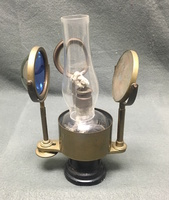
Microscope Lamp
The alcohol lamp has a brass circular fitting around the lower glass reservoir. The brass ring secures a magnifier, a blue-filtered condensing lens and a mirror to the lamp. The attachments can be adjusted by moving it around the lamp. -

Botanical "School" Microscope
The botanical entomological microscope consists of a brass tubular pillar stand that screws into the lid of the wooden case. At the top of the pillar is a fixed arm that holds the three stacking objectives that can be used together or individually. The round black stage with slide clips elevates up and down the pillar manually simply by lifting it up and down the pillar as desired. The gimbaled sub-stage mirror is attached to the lower pillar. The design was often called a "School Microscope" because it could be used for educational purposes such as particular examination of botanical specimens, small insects or insect parts, water fleas and other objects that could be readily collected and examined. This instrument is an English import and follows the design of the Society of Arts School Microscope of the 1855 time period. The design is similar to the earlier model of the Ellis Aquatic microscopes. It was also considered an inexpensive, simple microscope and became a popular model. The wooden case is secured by two swinging brass hooks. -
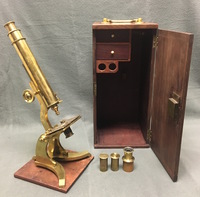
White and Barr Microscope
The compound monocular microscope is made from lacquered brass and mounted on trunnions. The microscope has a Y-shaped base which is mounted on a wooden platform. The microscope has coarse focusing via rack and pinion which is controlled by a thumbscrew located on the side of the support pillar. The support pillar is connected to the body-tube and the square stage is fixed. A polarizer is screwed into the bottom of the stage; however, there is no substage mirror present on the microscope. The fitted mahogany case has a brass carry handle. The two interior accessories drawers have ivory handles and there are two circular wooden cutouts to hold the objective canisters. The case has a functional lock but no key is present with the microscope. -

Drum Compound Microscope
The drum compound is made of lacquered brass. This style was manufactured in France, Germany and England and sold throughout the United States and Europe. Many of the microscopes manufactured using this design were unsigned due to the huge quantities sold by various makers. The microscope consists of a body tube suspended by a tubular base above a circular specimen platform. Coarse focusing is achieved via a sliding mechanism in which the body tube is moved closer or further away from the specimen platform. A bullseye condenser is attached to the front of the microscope which can be adjusted via the double-jointed arm. There is also a concave substage mirror located in the bottom of the microscope, which can be seen through a square cut out. The mirror can be adjusted by thumbscrews on either side of the microscope, however, the mirror is detached on one side. The "coffin-style" wooden case has compartment for the microscope and slides. The case is secured with two swing hooks. -

"Cary-Gould style" Field Microscope
The field microscope is made of brass and case-mounted onto a mahogany case which acts as the base. The pillar is secured into the lid of the case via a screw attachment at the bottom of the pillar. The stage is permanently attached to the pillar and coarse focusing functions by a rack and pinion which moves the stage closer or further from the objective. The arm is attached by sliding it into the top section of the pillar where it is secured by a thumbscrew. The objective lens are screwed directly into the end of the body-tube which can then be screwed into the arm. The stage has two clips that hold the specimen by placing the slide between the clip and the square stage. The sub-stage mirror is attached via a pin into the pillar. The mahogany fitted case has some marks and stains. The inside of the case is lined with blue velvet and has compartments to fit the dissembled microscope and accessories. The case is secured by two brass swing hooks on the sides.
